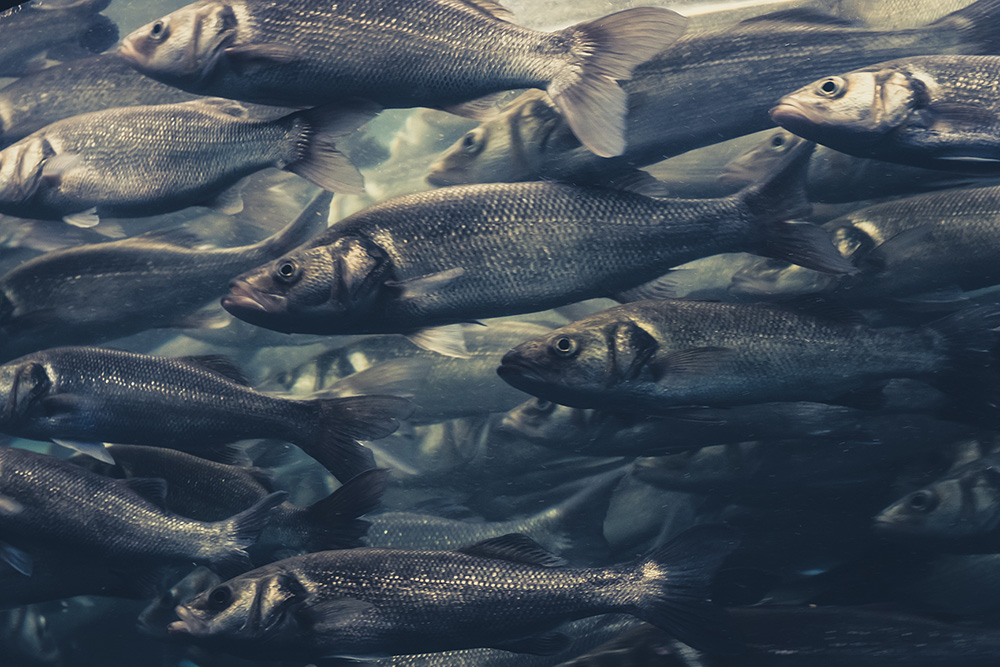
Herring, common name for fish of the widely distributed family Clupeidae. The true herring (Clupea harengus), a relatively small, bony, soft-rayed fish with an elongate, laterally compressed body, is silvery in colour, shading to bluish or bluish green on the back. One of the most abundant of fishes, it is widely distributed throughout temperate and subarctic waters of the Northern Hemisphere, and is the only member of the genus found in Canadian waters. Adults move in vast schools, often many kilometres long, and migrate annually to spawning grounds in shallower waters. Herring feed on larger zooplankton, abundant on or at the edge of the Continental Shelf. They are a major food of larger fishes (eg, cod, salmon, tuna, flatfishes) and birds.
Herring, abundant on Pacific and Atlantic coasts, also occur occasionally in Arctic waters. The Pacific subspecies (C. h. pallasi) differs from the Atlantic form (C. h. harengus) in several respects. Pacific herring spawn in spring, directly onto vegetation in intertidal and subtidal waters. They usually mature in their third year and seldom live more than 8 years. Their maximum standard length is about 26 cm. Atlantic herring spawn either in spring or autumn, usually over a gravel bottom. They mature in their fourth or fifth year, live 18 years or more and attain lengths of 35 cm or over.
Significance of Fishery
Herring have supported major commercial fisheries on both coasts. Both subspecies experience major population fluctuations caused by differences in brood survival. Prior to the mid-1900s, catches were limited by markets or catching capacities of fishing fleets. The development of an almost unlimited world market for herring meal and oil, plus major advances in fishing technology, led to overfishing of Pacific stocks 1956-66, when annual catches usually exceeded 200 000 t, and of Atlantic stocks 1968-71, when Canadian catches exceeded 400 000 t annually. Both fisheries have since been strictly regulated.
Pacific fishermen using mainly purse seines and gillnets took about 50 000 t annually during the late 1970s; this was further reduced to an average of 33 000 t in the early 1980s but recovered slightly in the early 1990s to almost 40 000 t. However, the value of the catch was much higher than before because of the prime price fetched on the Japanese market for quality herring roe, which makes up the majority of the catch. Catches of Atlantic herring averaged about 235 000 t during the late 1970s, taken primarily by purse seine and mid-water trawl for sale to European processors. Abundance declined on the East Coast also during the early 1980s, with catches averaging 189 700 t. In the early 1990s catches had risen to 217 000 t. A traditional weir fishery for young herring, for canning as sardines, operates in NB.
Distribution and Habitat
Seven other members of the family are found in Canadian waters. Atlantic round herring (Etrumeus sadina), Atlantic menhaden (Brevoortia tyrannus) and Pacific sardine or pilchard (Sardinops sagax) are ocean spawners most abundant in southern US waters. They are now rare and of no commercial importance in Canada, although Pacific sardines supported a major fishery in BC during a period of high abundance (mid-1920s to 1940s).
Alewife or glut herring (Alosa pseudoharengus), American shad (A. sapidissima) and blueback herring (A. aestivalis) are anadromous (eg, live in the sea but spawn in fresh water) on the Atlantic coast. They are also most abundant in the south, but alewife and American shad are relatively common in Canadian coastal waters, where they are fished commercially. American shad, introduced on the Pacific coast in 1871, is now found in the Fraser River and Rivers Inlet. A landlocked form of alewife is plentiful in the Great Lakes; many of its local names include the word "herring." There is also the gizzard shad (Dorosoma cepedianum) of the Great Lakes basin. At least 4 other freshwater fishes (2 ciscos, goldeye and mooneye) are also known by names sometimes containing the word "herring."

 Share on Facebook
Share on Facebook Share on X
Share on X Share by Email
Share by Email Share on Google Classroom
Share on Google Classroom



